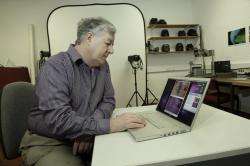Whose Tattoo Is It Anyway?

(PhysOrg.com) -- An infra-red digital camera could be a crucial tool in the fight against crime when trying to identify suspects by their tattoos, according to new University of Derby research.
Forensic scientists and detectives traditionally focus on distinguishing features of a suspect when looking to track down offenders - and suspects sporting tattoos can help provide a crucial lead in an investigation.
However, criminals can stay one step ahead of the game by revising or updating their tattoo to escape justice.
Now University of Derby forensic science experts are exploring how using an infra-red digital camera can determine if a tattoo is an original, or if it is a second tattoo covering the old one.
A traditional colour camera only picks up what is on the surface of the skin, but using a digital camera sensitive to infra-red, researchers can see if there are hidden layers or changes to the original tattoo deeper in the skin.
In a recent experiment, the technique was able to determine that on a student's back, a butterfly image had covered up an image of an imp, in the original tattoo.
David Bryson is a Senior Lecturer at Derby in Applied Photography and Forensic Science and also specializes in the area of Forensic Imaging. He has been working on this project with a number of students studying forensic science at degree level.
He said: "Identifying individuals using tattoos has been an established part of forensic science practice for some time, but there can be cover-ups of tattoos with lasers, more tattoos or surgery.
"It is now possible to take a control photograph and a separate photograph with an infra-red filter to take images of the tattoo, and determine if it is indeed the original or is a cover-up, or altered tattoo on the surface.
"Digital photography means that moments after the images have been taken, they can be viewed on a laptop or computer screen - making this interesting approach now more feasible for use in everyday forensic work, compared to more traditional processes."
Further work is now being undertaken at the University's laboratories at Kedleston Road, Derby, to look at the criteria that leads to the underlying tattoo being visible to infra-red or not visible to infra-red.
This will involve looking at three different aspects of tattoos: the effect of different types of cover-up tattooing or tattoo removal by surgery or laser, differentiation of ink types and the depth of penetration, which can vary from 0.6mm to 2.2mm into the skin.
Once the research has gone further, David will be looking at trialling digital infra-red photography in police forces as an everyday tool to look at tattoos on suspects.
Other forensic work trialled at the University using photography techniques include analysing lipstick left on coffee cups, ear prints found on glass and fingerprint analysis.
Provided by University of Derby


















